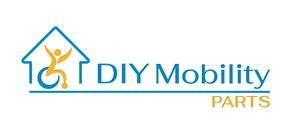Buying Tips for Bearings
Wheelchair and Scooter Bearings
Bearings are used when an object needs to rotate. On wheelchair and scooters, bearings are often found in the caster wheels, caster forks, rear wheels, suspension arms, swivel wheels, motors, and gearboxes. Bearings wear over time resulting in poor performance. There are some visible and auditory indicators that can help identify if a bearing is worn.
- Tire does not freely spin or requires added effort to rotate or push
- Surface rust
- Noises such as squeaks or grinding
- Complete bearing failure
Measuring your Bearing
Most wheelchair bearings are replaceable. Knowing the size of the bearing, reference number, and type of bearing can help you identify a replacement. When measuring your bearing, measure the Outer Diameter, Inner Diameter, and Width. Also collect the Bearing reference number which is often printed into the metal of the bearing.
With these measurements, you can now search our bearing products to find a replacement bearing with the same measurements. See the image below showing how to measure and characterize a bearing.

Many bearings found on wheelchairs and scooters have a reference number stamped on the side of the bearing which refers to the type and size of the bearing. In most cases, that is all you need to purchase the correct bearing. Suffixes indicate the type of seal or shield the bearing has such as rubber seals (RS, 2RS) or metal shields (Z, ZZ). If the bearing reference appears worn off, you may be able to see it stamped on the other side. You should also note whether the bearing has a flange or snap ring attached to it.
Ready to Search our Bearing Selection?
Wheelchair / Scooter Bearing Page
Other possible issues to consider:
It might not just be the bearing. Here are a few other items to look at.
- Caster wheels: Check if the casters spin freely by giving them a spin. Look closely for any hair or debris that might be caught around the axle, as this can restrict their movement and make it seem like the bearing is bad.
- Caster forks: Ensure the forks are straight and aligned. A bent caster fork can make the chair difficult to roll or steer straight. Test this by pushing the chair on a flat surface—it should roll in a straight line. If not, you might need new caster forks rather than bearings. If the fork feels loose or wobbly, ensure it’s properly tightened, as a loose fork can mimic the symptoms of worn bearings.
- Rear wheels: Verify that the wheels roll freely and don’t wobble. If a wheel wobbles, check that the axle is secure and fully tightened. Often, play in the rear wheel is due to an improperly tightened axle. For quick-release axles, adjust the mechanism (usually located under the release button) to eliminate excess slack if the wheel feels loose.
Bearing Installation Tips
- Bearing Removal: Use a long blunt object, like a screwdriver, to push out the bearing from one side by applying pressure on the inner race (the center part). Flip the caster or wheel and repeat for the other side. For wheelchair caster fork barrels, you’ll need to remove the caster fork first. Lay the wheelchair on its side (for manual wheelchairs) or prop it up (for power wheelchairs) for easier access.
- Handling Spacers and Washers: If there’s a spacer between the bearings on wheels, save it for reinstallation. For caster fork barrels, note the order and placement of multiple spacers and washers to ensure proper reassembly.
- Bearing Install: Most bearings fit into place with minimal effort, though some may require gentle force. Avoid excessive pressure, as this can damage the wheel or housing. A rubber mallet is ideal for installation; for added protection, place a cloth or a block of wood with a cloth on both sides of the caster or wheel. Install the bearing on one side, reinsert the spacer (if applicable), then flip over and repeat for the other side.
- Choosing a selection results in a full page refresh.

